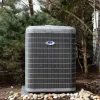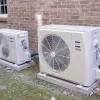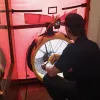You can’t see inside your walls. That’s obvious, right?
Aside from tearing out all the sheetrock, the only way to see what’s behind your walls is to drill a hole and snake a camera around. Even then, you can’t see every last detail of what’s back there. You only see bits and pieces.
The same is true for heat exchangers.
Back in the day, the only way to check a heat exchanger for cracks was to perform a visual inspection. It was better than nothing, but it was still only slightly better than flipping a coin.
Later, we got scopes and camera equipment. That showed us more of the heat exchanger, but it still didn’t show us everything. Depending on the furnace design, it might only be possible to examine 10% of the entire heat exchanger.
And what did it mean if the camera revealed a crack? Is the crack deep enough to leach carbon monoxide (CO)? If so, how much? Needless to say, visual heat exchanger analysis provides woefully inadequate answers to these very important questions.
A combustion analyzer provides accurate CO readings. It’s the best way to examine your heat exchanger for cracks.
Nowadays, checking for a cracked heat exchanger is way more scientific.
A combustion analyzer gives us CO and oxygen readings. We use it to check CO levels (given in parts per million, or PPM) and determine for sure whether there’s a crack in your heat exchanger. The combustion analyzer also helps us gauge the overall performance of your furnace.
If the heat exchanger is cracked, the meter will show us. If it isn’t cracked, we’ll know it. You won’t have to replace your furnace prematurely.
Combustion analyzer readings are light years ahead of visual inspection results.
It’s difficult to underscore just how much more accurate a combustion analyzer is versus taking some pictures and guessing about what you see. It’s a gigantic improvement!
- Combustion analysis results in safer homes. If you’ve got dangerous CO levels in your home, the combustion analyzer will tell us. You won’t have to worry about a faulty visual inspection failing to reveal any problems.
- Combustion analysis can save you money. Many HVAC contractors find “cracked” heat exchangers using visual analysis and use the results to recommend furnace replacement. Sometimes, they’re wrong. You might not need to replace your furnace.
We’ve met with lots of homeowners looking for a second opinion about a supposedly cracked heat exchanger. Where other companies said there were cracks, we found… nothing. Zip. Nada. Just a safe (uncracked) heat exchanger.
In some cases, these were big-name local HVAC contractors giving the faulty diagnosis. Why? Because they still only perform visual heat exchanger inspections. Crazy, but true.
They told the homeowner it was time for a new furnace. It wasn’t.
Heat exchangers aren’t the only place to check for CO.
Potential CO sources are numerous. The heat exchanger is one of them, and we check it during every fall maintenance inspection. But you probably have other combustion appliances, like water heaters. CO can leak from those as well.
In some older homes, we see water heaters and furnaces that vent into a chimney. Over time, the clay liners develop cracks. CO can leak into the home when there’s enough negative pressure. In other cases, old chimneys are simply too big to effectively vent the CO produced by a new, energy-efficient furnace. We perform special tests for these problems and offer specific recommendations for anything we encounter.
Ultimately, you don’t want any CO leaking into your home, no matter how low the PPM reading is. When there’s CO present, we’ll know it.
So don’t take any chances with visual analysis.
It’s not worth it. CO is dangerous and a new furnace is expensive when you don’t need one.
Be sure to work with a contractor who uses a combustion analyzer to check your heat exchanger. Having a well-rounded understanding of CO issues – including the most common sources of CO leaks – is important, too.
There’s just too much at stake to settle for less.






